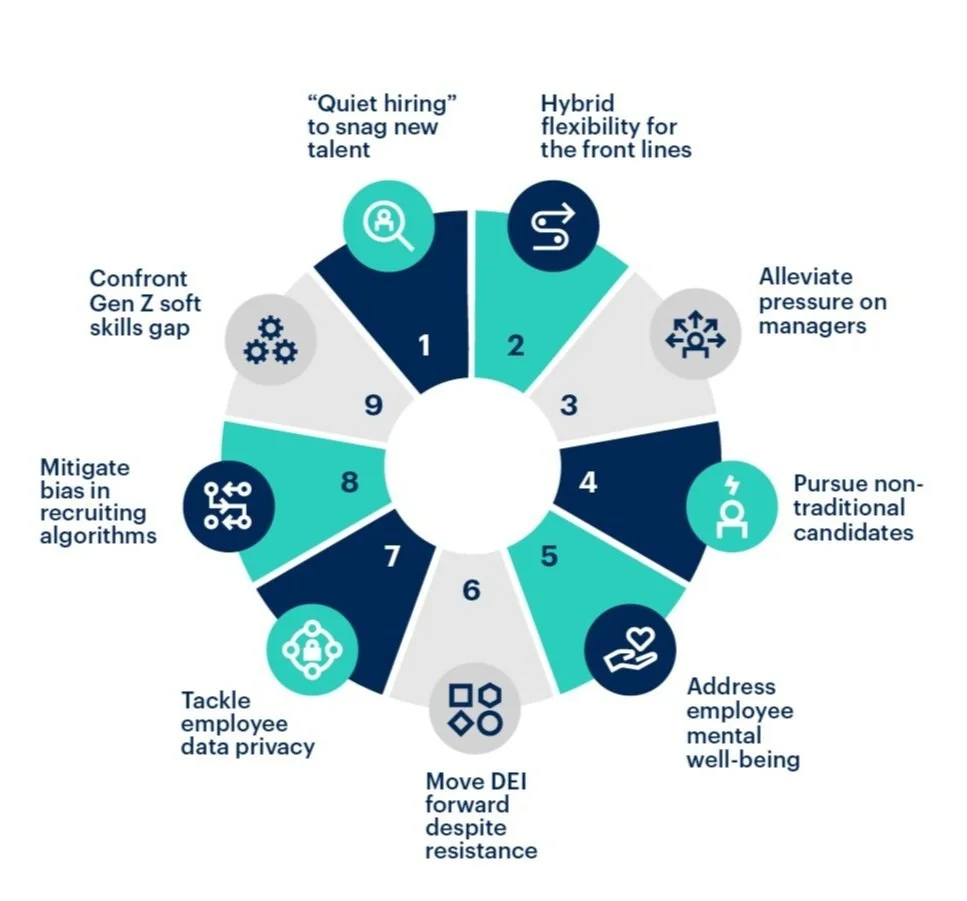9 Future of Work Trends For 2023
FROM GARTNER HUMAN RESOURCES / BY EMILY ROSE McRAE & PETER AYKENS
How you respond to them could determine whether you’re an employer of choice.
As we enter the third year since COVID-19 came into existence, the virus has proven to have a lasting impact on the future of work. In 2023, organizations face historic challenges: a competitive talent landscape, an exhausted workforce, and pressure to control costs. In this environment, it’s imperative to tackle the following nine trends as your organization sets strategic workforce and talent goals.
Trend No. 1: “Quiet hiring” offers new ways to snag in-demand talent
Anyone on LinkedIn remembers the viral wave of “quiet quitting” headlines from the second half of 2022: the idea of employees refusing to go “above and beyond” and doing the minimum required in their jobs. When employees “quiet quit,” organizations keep people but lose skills and capabilities. In 2023, savvy HR leaders will turn this practice on its head with “quiet hiring” in order to acquire new skills and capabilities without adding new full-time employees. This will manifest in a few key ways:
A focus on internal talent mobility to ensure employees address the priorities that matter most without changes in headcount
Stretch and upskilling opportunities for existing employees while meeting evolving organizational needs
Alternate approaches, such as leveraging alumni networks and gig workers, to flexibly bring in talent only as needed
Trend No. 2: Hybrid flexibility reaches the front lines
As we enter a more permanent era of hybrid work for desk-based employees, it’s time to find equitable flexibility for frontline workers, like those in manufacturing and healthcare. According to the 2022 Gartner Frontline Worker Experience Reinvented Survey, 58% of organizations that employ frontline workers have invested in improving their employee experience in the past year. About a third of those who haven’t intend to do so in the next 12 months.
As organizations look to offer more flexibility for their frontline workforce, note that a recent Gartner survey shows the top role attractors for this segment include:
Control over work schedule
Paid leave
Stability in work schedule
Frontline workers also express interest in other types of flexibility, such as what they work on, who they work with and the amount they work.
Trend No. 3: Squeezed by competing leader and employee expectations, managers need support
The demands of today’s working environment have left managers completely out of their depth. They feel pressure from above and below: they must implement corporate strategy with regard to hybrid work while also providing a sense of purpose, flexibility and career opportunities.
Low- and midlevel managers are now the colleagues with whom their direct reports most regularly interact, and 60% of hybrid employees say their direct manager is their most direct connection to company culture.
Management is a skill, and for most people, it takes practice. The dual pressures of remote work and employees’ evolving needs and expectations have amplified poor management. In 2023, the best organizations will take two key actions to relieve pressure on managers. They will:
Provide fresh support and training to mitigate the widening managerial skills gap. The approaches that were successful in 2019 are ill-suited for the workforce of 2023.
Clarify manager priorities, make it clear how managers should allocate their time and redesign their roles where necessary.
Trend No. 4: Pursuit of nontraditional candidates expands talent pipelines
For years, organizations have talked about the strategic value of expanding and diversifying their talent pipelines. Now it’s time to back up those words with actions. Two key trends have emerged:
Employees are charting nonlinear career paths: 56% of candidates report applying for jobs outside their current area of expertise, and we expect this figure to climb further in the coming years.
Organizations can no longer meet their talent needs through traditional sourcing methods and candidate pools. Plus, hiring managers are less concerned with industry experience and technical skills than they once were.
To fill critical roles in 2023, organizations will need to become more comfortable assessing candidates solely on their ability to perform in the role, not their credentials and prior experience. It’s more urgent than ever to rethink outdated assumptions about qualifications.
Trend No. 5: Healing pandemic trauma opens path to sustainable performance
Most humans, and that includes current and incoming employees, are still experiencing pervasive mental health challenges as a result of the societal, economic and political turbulence of recent times. This may decrease productivity and performance, as well as increase angry outbursts, no-notice quitting, workplace conflict and sudden underperformance.
Eighty-two percent of employees now say it’s important that their organizations see them as a whole person, rather than simply an employee. In the coming year, the best organizations will implement:
Proactive rest to help employees maintain their emotional resilience and performance, rather than offering rest as a recovery solution after both have plummeted. This may include proactive PTO before high-demand working periods, no-meeting Fridays, allotted wellness time and managers being goaled on their team taking adequate PTO.
Discussion opportunities to work through challenges and difficult topics without judgment or consequences.
Trauma counselors to provide on-site counseling, and train and coach managers on workplace conflict as well as how to have difficult conversations with employees.
Trend No. 6: Organizations push DEI forward amid growing pushback
As organizations bolster diversity, equity and inclusion (DEI) efforts, some employees are showing signs of resistance. Forty-two percent of employees believe their organization’s DEI efforts are divisive. And two out of five agree that a growing number of employees feel alienated by or even resent their organization’s DEI efforts.
Political and ideological trends that characterize DEI as social engineering or discrimination against historically favored groups amplify this resistance. Employee pushback invalidates, disrupts or disconnects from programs meant to enable marginalized groups. It can be obvious or subtle, and it can be deliberate, but is often unintentional.
While many organizations ignore employee pushback because they fear validating it as legitimate, left unchecked, it may decrease engagement and inclusion, and ultimately result in attrition. In 2023, savvy leaders will address the opposition early, before it evolves into more disruptive forms of resistance.
Trend No. 7: Getting personal with employee support creates new data risks
Organizations are using emerging technologies (AI assistants, wearables, etc.) to collect data on employees’ health, family situations, living conditions, mental health and even sleep patterns in order to respond more effectively to their needs.
This creates a looming privacy crisis. Technological capabilities are expanding more quickly than leaders can fully understand and control. Being a human organization means knowing more about people, not just employees — a shift that has the potential to violate boundaries around deeply personal and private information.
In 2023, employers must prioritize transparency around how they collect, use and store employee data, as well as allow employees to opt out of practices they find objectionable.
Start building an employee data bill of rights to support your employees’ need for healthy boundaries in addition to overall well-being.
Trend No. 8: Algorithmic bias concerns lead to more transparency in recruiting tech
Organizations that use AI and machine learning in their hiring processes — as well as the vendors they rely on for these services — will face pressure to get out ahead of new government regulations on privacy. They must be more transparent about how they are using AI, publicize their data audit, and give employees and candidates the choice to opt out from AI-led processes.
As more organizations begin using AI in recruiting, the ethical implications of these practices for fairness, diversity, inclusion and data privacy become increasingly salient.
Trend No. 9: Gen Z skills gaps reveal workforce-wide erosion of social skills
The social isolation brought about by the pandemic has hit young people hard: 46% of Gen Z employees we recently surveyed say that the pandemic made pursuing their educational or career goals more difficult, and 51% say that their education has not prepared them to enter the workforce. Gen Z has missed out on developing soft skills, such as negotiating, networking, speaking confidently in front of crowds, and developing the social stamina and attentiveness required to work long hours, in an in-person environment.
This lack of experience and preparedness may negatively impact organizations, especially as they aim to hire cheap talent in a tight labor market. But it’s not just Gen Z — everyone’s social skills have eroded since 2020. Burnout, exhaustion and career insecurity — all heightened during the pandemic — negatively impact performance. Organizations will need to redefine professionalism for their entire workforce to address this challenge.
In short:
Organizations face historic challenges with a competitive talent landscape, an exhausted workforce, and pressure to control costs.
In 2023, executives must get savvy to snag in-demand talent, focus on employee mental health and confront data ethics in new HR technology.
These nine high-impact trends create an exciting opportunity for organizations to differentiate themselves as employers of choice.



